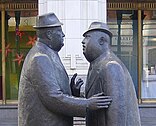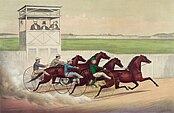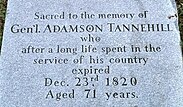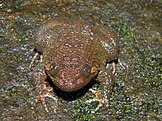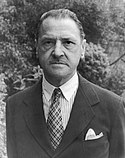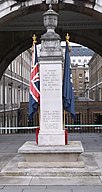Wikipedia:Today's featured article/January 2024
| << | Today's featured articles for January 2024 | >> | ||||
|---|---|---|---|---|---|---|
| Su | Mo | Tu | We | Th | Fr | Sa |
| 1 | 2 | 3 | 4 | 5 | 6 | |
| 7 | 8 | 9 | 10 | 11 | 12 | 13 |
| 14 | 15 | 16 | 17 | 18 | 19 | 20 |
| 21 | 22 | 23 | 24 | 25 | 26 | 27 |
| 28 | 29 | 30 | 31 | |||
January 1
The koala is an arboreal plant-eating marsupial native to Australia, recognised worldwide as a symbol of the country. Its closest living relatives are the wombats. It has a stout, tailless body and large head with round, fluffy ears and a large, dark nose. The koala has a body length of 60 to 85 cm (24 to 33 in) and weighs 4 to 15 kg (9 to 33 lb). Fur colour ranges from silver grey to chocolate brown. Koalas typically inhabit open Eucalyptus woodlands, and the leaves of these trees make up most of their diet. Because this eucalypt diet has low nutritional and caloric content, koalas are largely sedentary and sleep for up to 20 hours a day. They are asocial animals, and bonding only exists between mothers and dependent offspring. They have few natural predators or parasites but are threatened by various pathogens, as well as by bushfires and droughts. The biggest threat to their existence is habitat destruction due to agriculture and urbanisation. (Full article...)
January 2
The Masked Singer is an American reality singing competition television series that premiered on Fox on January 2, 2019. It is part of the Masked Singer franchise and features celebrities singing songs while wearing costumes to conceal themselves. The program employs panelists who guess the celebrities' identities. In most episodes, after the last performance, a vote of the panelists and the audience eliminates a contestant, who is then revealed. The costumes were inspired by haute couture and designed in the first six seasons by Marina Toybina (pictured), who won a Costume Designers Guild Award and two Creative Arts Emmy Awards. The first five seasons received the highest Nielsen ratings for a non-sports program in the key demographic of adults 18–49. Its success has been credited to the growth of the Masked Singer franchise and interest in adapting South Korean reality television series and other television formats centered on costumes. The tenth season premiered in September 2023. (Full article...)
January 3
A 1–1 tie in 26 innings was played by the Brooklyn Dodgers and Boston Braves on May 1, 1920, at Braves Field in Boston, still the most innings played in a Major League Baseball (MLB) game. Leon Cadore of Brooklyn and Joe Oeschger of Boston each pitched 26 innings, also a one-game record. Brooklyn scored its only run in the fifth inning, as did Boston in the sixth, and, though both teams threatened to score again several times, the game remained deadlocked. With darkness starting to fall and no artificial lighting, the umpires called a halt after the 26th inning. Other records included Charlie Pick's 11 at bats in a game without a base hit and first baseman Walter Holke's 42 putouts. There have been claims that the long pitching appearances ruined the arms of Oeschger and Cadore; this was not so as both pitched several more years in MLB and Oeschger won 20 games in 1921. Their shared record of 26 innings pitched in an MLB game has been repeatedly cited as one that will never be broken. (Full article...)
January 4
Robert Nimmo (1893–1966) was a senior Australian Army officer and the chief military observer (CMO) of the United Nations Military Observer Group in India and Pakistan (UNMOGIP) from 1950 until his death. Nimmo graduated early from the Royal Military College, Duntroon, to serve in World War I with the Australian Light Horse. He remained in Australia in training and staff roles early in World War II. He then administered command of Northern Territory Force before commanding the logistics effort for the Bougainville campaign, and served as a senior staff officer on First Australian Army headquarters in New Guinea. He commanded a brigade of the British Commonwealth Occupation Force in Japan, then returned to Australia to lead Northern Command. In 1950, he was made Commander of the Order of the British Empire, retired from the army, and was appointed as CMO of UNMOGIP, where he remained until he died on 4 January 1966. Nimmo was the first Australian to command a multinational peacekeeping force. (Full article...)
January 5
Kyla (born January 5, 1981) is a Filipino singer-songwriter. She is the recipient of numerous accolades, including eleven Awit Awards and three MTV Pilipinas Music Awards. She gained recognition in 2000 with her debut album Way to Your Heart and its single "Hanggang Ngayon", which won the International Viewer's Choice Award for Southeast Asia at the 2001 MTV Video Music Awards. She has collaborated with musicians such as American singer-songwriter Brian McKnight and English boy band Blue. Outside of music, she has starred in the drama series Dear Friend (2009) and Villa Quintana (2013–2014), and has expanded her career into reality television as a presenter of the talent competition show Popstar Kids (2005–2007) and as a judge in the variety show singing contest Tawag ng Tanghalan (since 2016). Kyla's music is primarily influenced by R&B and soul, and she has been credited with helping to redefine the genres in the Philippines. (This article is part of a featured topic: Overview of Kyla.)
January 6
A supernova is a powerful explosion of a star, usually a star that is unable to produce sufficient energy from nuclear fusion to counteract its own gravity. Its remnant will become a diffuse nebula, neutron star or black hole. The peak optical luminosity of a supernova can be comparable to that of an entire galaxy before fading over several weeks or months. Supernovae occur in the Milky Way on average about three times every century; the last one directly observed was Kepler's Supernova (remnant pictured) in 1604. The most recent naked-eye supernova from another galaxy was SN 1987A, the explosion of a blue supergiant star in the Large Magellanic Cloud, a satellite of the Milky Way. Supernovae can expel several solar masses of material at velocities up to several percent of the speed of light. They are a major source of cosmic rays, and also the chemical elements from oxygen to rubidium on the periodic table. White dwarfs can also produce supernovae, if they gain enough mass to trigger runaway fusion. (Full article...)
January 7
Daisy Bacon (1898–1986) was an American pulp fiction magazine editor and writer, best known as the editor of Love Story Magazine from 1928 to 1947. She was hired in 1926 to assist with "Friends in Need", an advice column in the magazine, by Street & Smith, a major pulp magazine publisher. Two years later she was promoted to editor. Love Story was one of the most successful pulp magazines, and Bacon was frequently interviewed about her role and her opinions of modern romance. Street & Smith gave Bacon other magazines to edit, including Ainslee's in the mid-1930s and Pocket Love in the late 1930s. From 1940 to 1947 she took over as editor of Romantic Range, which featured love stories set in the American West, and in 1941 she was also given the editorship of Detective Story. In late 1948 she became the editor of both The Shadow and Doc Savage, but Street & Smith shut down all their pulps the following April. (Full article...)
January 8
Shostakovich v. Twentieth Century-Fox Film Corp. is a landmark 1948 New York Supreme Court decision. It was the first case in the United States dealing with moral rights in authorship. The Soviet composers Dmitri Shostakovich (pictured), Aram Khachaturian, Sergei Prokofiev, and Nikolai Myaskovsky sued Twentieth Century-Fox Film Corporation for using their compositions in the film The Iron Curtain. Although their compositions were in the public domain in the United States, the composers argued that the film violated their moral rights by using their works in a manner contrary to their beliefs. The court rejected the composers' argument, holding that there was no clear standard for adjudicating moral rights and that moral rights conflict with free use of public domain works. The decision has been criticized for misunderstanding moral rights and praised for upholding the right of the public to use public domain works over the rights of authors to censor uses that they disagree with. (Full article...)
January 9
Communication is commonly defined as the transmission of information. Many models of communication describe it in terms of a source using a coding system to express ideas in the form of a message. The message is sent through a channel to a receiver who decodes it to understand it. For verbal communication, the message is articulated in linguistic form, including regular speech and writing. Nonverbal communication, including body language, touch, and facial expressions, does not rely on a linguistic system. The history of human communication was shaped by the development of technologies such as writing, printing, radio, and the internet. Communication also happens among animals and plants, for example when birds sing to attract mates. Interspecies communication occurs between distinct species, such as flowers using distinctive colors to signal to bees where nectar is located. The main discipline investigating communication is called communication studies. (Full article...)
January 10
The Firebird is a ballet and orchestral concert work by the Russian composer Igor Stravinsky. It was written for the 1910 Paris season of Sergei Diaghilev's Ballets Russes company; the original choreography was by Michel Fokine, who collaborated with Alexandre Benois and others on a scenario based on the Russian fairy tales of the magical Firebird and the blessing and curse it possesses for its owner. Set in the evil immortal Koschei's castle, the ballet follows Prince Ivan, who battles Koschei with the help of the Firebird. It was an immediate success, catapulting Stravinsky to international fame and leading to future collaborations between Diaghilev and Stravinsky, like Petrushka (1911) and The Rite of Spring (1913). Other choreographers have reinterpreted the music with new productions, settings and themes. Stravinsky's 1919 concert suite remains the most popular today. A film version with the original choreography, featuring what is now the Royal Ballet, was created in 1959. (Full article...)
January 11
The rock parrot (Neophema petrophila) is a species of grass parrot native to Australia. Described by John Gould in 1841, it is a small parrot 22 to 24 cm (8+3⁄4 to 9+1⁄2 in) long and weighing 50 to 60 g (1+3⁄4 to 2 oz) with predominantly olive-brown upperparts and more yellowish underparts. Its head is olive with light blue forecheeks and lores, and a dark blue frontal band line across the crown with lighter blue above and below. The sexes are similar in appearance, although the female tends to have a duller frontal band and less blue on the face. The preferred habitats are rocky islands and coastal dune areas from Lake Alexandrina in southeastern South Australia westwards across coastal South and Western Australia to Shark Bay. Unlike other grass parrots, it nests in burrows or rocky crevices mostly on offshore islands such as Rottnest Island. Seeds of grasses and succulent plants form the bulk of its diet. The species is not threatened, but it has suffered in the face of feral mammals. (Full article...)
January 12
SMS Prinz Adalbert was an armored cruiser built in the early 1900s for the German Kaiserliche Marine, and was named after Prince Adalbert of Prussia, the former commander-in-chief of the Prussian Navy. Her class included a second ship, Friedrich Carl. Prinz Adalbert was built at the Imperial Dockyard in Kiel. Her keel was laid in April 1900 and she was commissioned on 12 January 1904. She served as a gunnery training ship and made several visits to foreign countries. After the outbreak of World War I in July 1914 she served in the Baltic Sea, and after her sister ship was sunk in November 1914, she became the flagship of a cruiser squadron in the Baltic, conducting operations against Russian forces. She was torpedoed twice by British submarines in 1915. On the second occasion she sank quickly with heavy loss of life; from a crew of 675 men, only 3 were rescued. This was the worst German naval disaster in the Baltic during the war. (This article is part of a featured topic: Armored cruisers of Germany.)
January 13
Carucage was a medieval English land tax based on the size of the taxpayer's estate. It was levied six times: by Richard I in 1194 and 1198, John in 1200, and Henry III in 1217, 1220, and 1224. The taxable value of an estate was initially assessed from the Domesday Book survey, but other methods were later employed, such as valuations based on the sworn testimony of neighbours or the number of plough-teams (example depicted) the taxpayer used. Carucage never raised as much as other taxes, but it helped fund the ransom for Richard's release in 1194, the tax John paid to Philip II of France on land he inherited in that country, and the cost of Henry III's military campaigns in England and continental Europe. The tax was an attempt to secure new sources of revenue when new demands were being made on royal finances. Unlike the older danegeld tax, carucage was an experiment in revenue collection and only levied for specific purposes. (Full article...)
January 14
Fleetwood Park was a 19th-century American harness racing track in the Bronx, New York City. The races were a popular form of entertainment, drawing crowds as large as 10,000. The one-mile (1.6 km) course described an unusual shape, with four turns in one direction and one in the other. For the last five years of operation, Fleetwood was part of trotting's Grand Circuit, one travel guide calling it "the most famous trotting track in the country". The track operated under several managements between 1870 and 1898, most notably the New York Driving Club, consisting of many wealthy New York businessmen, including members of the Vanderbilt and Rockefeller families as well as former US president Ulysses S. Grant and Robert Bonner, owner of the New York Ledger. Economic pressures forced the track to close in 1898, and within two years the property was being subdivided into residential building lots. The meandering route of modern 167th Street runs along a portion of the old racecourse. (Full article...)
January 15
WWJ-TV (channel 62) is a television station broadcasting in Detroit, Michigan, United States. It is owned and operated by the CBS News and Stations group, with studios in the suburb of Southfield. Channel 62 was founded as WGPR-TV in 1975 by William V. Banks as the first Black-owned television station in the continental United States. It produced its own shows and helped launch the careers of Black television hosts and executives such as Pat Harvey, Shaun Robinson, Sharon Dahlonega Bush, and Amyre Makupson. In 1994, when a major affiliation switch threatened to leave CBS without an affiliate station in Detroit, the network moved to buy WGPR-TV and dropped the existing programming in favor of CBS and syndicated programs, later changing the call letters to WWJ-TV. The station's original studios (pictured) are listed on the National Register of Historic Places and preserved as a museum that opened on Martin Luther King Jr. Day in January 2017. A full news department began operation in January 2023. (Full article...)
January 16
Adamson Tannehill (1750–1820) was an American military officer, politician, civic leader, and farmer. Born in Maryland, Tannehill was among the first to join the Continental Army during the American Revolutionary War, becoming commander of the Maryland and Virginia Rifle Regiment. He then settled in Pittsburgh, Pennsylvania, where he was active in the state militia, rising to the rank of major general in 1811. He also served as a brigadier general of United States Volunteers in the War of 1812. Tannehill held several local, state, and national offices, including one term as a Democratic-Republican in the U.S. House of Representatives from 1813 to 1815. He was president of the Pittsburgh branch of the Bank of the United States from 1817 until his death. He also served on the founding boards of several civic and state organizations. Tannehill died in 1820 and was buried at his Grove Hill home outside Pittsburgh. He was later reinterred in Allegheny Cemetery (gravestone pictured). (Full article...)
January 17
The music for three of the four operas written by the youthful composer George Frideric Handel (pictured) between 1703 and 1706, when he lived in the German city of Hamburg, is lost apart from a few orchestral fragments. Only the first, Almira, has survived complete. He was able to get Almira and the less successful Nero performed at Oper am Gänsemarkt, the opera house, during the temporary absence of the theatre's director, Reinhard Keiser. Handel's last two Hamburg operas, Florindo and Daphne, were not produced before Handel left the city. No music that can be definitively traced to Nero has been identified, although some of it may have been used in later works, particularly Agrippina, which has a similar plot and characters. Fragments of music from Florindo and Daphne have been preserved without the vocal parts, and some of these elements were incorporated into an orchestral suite first recorded in 1997. (Full article...)
January 18
Mark Baldwin (1863–1929) was an American right-handed professional baseball pitcher who played seven seasons in Major League Baseball (MLB). Born in Pittsburgh, Baldwin made his professional debut for a Cumberland, Maryland, team in 1883. He made his MLB debut for the Chicago White Stockings in 1887. Baldwin signed with the Columbus Solons of the American Association in 1889, and led the league in innings pitched (513+2⁄3), losses (34), strikeouts (368), and walks (274). In 1890, he played for the Chicago Pirates of the Players' League and was the league leader in games played as a pitcher (58), innings pitched (492), wins (33), strikeouts (206), complete games (53), and walks (249). He later played for the Pittsburgh Pirates and New York Giants, then went on to a career as a physician. In 346 career MLB games, he pitched to a 154–165 win–loss record with 295 complete games. Baldwin set the single-season MLB wild pitches record with 83 that still stands today. (Full article...)
January 19

Homeworld is a real-time strategy video game developed by Relic Entertainment and published by Sierra Studios (co-founder pictured) in 1999 for Microsoft Windows. The science fiction game follows exiles on a spacecraft-constructing mothership who aim to reclaim their ancient homeworld, encountering pirates, mercenaries, traders, and rebels along the way. The player's fleet carries over between levels, and can travel in a fully three-dimensional space. Alex Garden of Relic served as the game's director, and Luke Moloney was lead programmer. Metacritic lists Homeworld as the highest rated computer game of 1999 and the third-highest on any platform for the year, although critical opinions were divided on its plot and high difficulty. The game sold over 500,000 copies in its first six months, and received several awards and nominations for best strategy game of the year and best game of the year. Gearbox Software purchased the game rights in 2013 and released a remastered collection in 2015. (Full article...)
January 20
Theodore II Laskaris (1221/1222–1258) was a Byzantine emperor who ruled the Empire of Nicaea from 1254 until his death. Nicaea was a successor state to the Byzantine Empire, after crusaders captured the Byzantine capital, Constantinople, in 1204 during the Fourth Crusade. Theodore began to write treatises on theological, historical and philosophical themes in his youth. From around 1242, he was co-ruler with his father, and his relationship with some prominent aristocrats grew tense. Succeeding his father in 1254 Theodore replaced many aristocratic officials and generals with loyalists, including some of low birth. In 1256, he repelled a Bulgarian invasion of Thrace and Macedonia and forced Epirus to cede Dyrrachium on the Adriatic Sea. Epirus allied with Serbia and Sicily, and jointly invaded Nicaea in 1257; Nicaea's new generals could not resist the invasion. Theodore died in 1258, leaving an underage son, John IV. Michael Palaiologos seized the regency, and usurped the throne soon after. (Full article...)
January 21
"Never Forget You" is a song recorded by American singer Mariah Carey (pictured) for her third studio album Music Box. Carey co-wrote the slow jam with Babyface and the pair produced it with Daryl Simmons. Columbia Records released the song on January 21, 1994, as the B-side to "Without You" and promoted it to American urban contemporary radio stations as the album's fourth single. The lyrics lament the end of a romance. Strings, synthesizers, and percussion characterize the composition; Jermaine Dupri altered them for remixes. Music critics deemed "Never Forget You" unremarkable and derivative. The song peaked at numbers one and three on the US urban contemporary radio charts published by Radio & Records and the Gavin Report, respectively. It also reached number three on the Billboard Hot 100 and number seven on the Billboard Hot R&B Singles chart. Combined with "Without You", the single sold 600,000 copies in the US throughout 1994. (Full article...)
January 22
Edward Oxford (1822–1900) was an English man who made an assassination attempt on Queen Victoria in 1840. After losing a series of jobs in pubs due to erratic and violent behaviour, he bought two pistols and fired twice at the queen and her husband, Prince Albert; neither shot hit anyone. Charged with high treason, he was found by a jury to be not guilty by reason of insanity, and was detained at Bethlem Royal Hospital and Broadmoor Hospital. Offered exile in 1867, he settled in Melbourne, Australia, under a new name. He worked as a decorator, married and became a respected figure at his local church. He began writing stories for The Argus on the seedier aspects of Melbourne, and later published a book, Lights and Shadows of Melbourne Life. Oxford's trial and the 1843 trial of Daniel M'Naghten, who killed civil servant Edward Drummond, prompted the judiciary to frame the M'Naghten rules on instructions to be given to a jury for a defence of insanity. (Full article...)
January 23
Nyctibatrachus major, the Malabar night frog, is a species in the robust frog family. First described in 1882 by George Albert Boulenger, it is a large Nyctibatrachus frog, with an adult snout–vent length of 31.5–52.0 mm (1.24–2.05 in) for males and 43.7–54.2 mm (1.72–2.13 in) for females. It is mainly brownish to greyish in colour, with a greyish-white underside, light grey sides, and grey or brown markings. Sexes can be told apart by the bulbous glands near the inner thigh in males. The species is endemic to the Western Ghats mountain range of India, in Kerala, Tamil Nadu, and Karnataka. Adults are nocturnal and inhabit fast-moving forest streams at elevations of up to 900 m (3,000 ft). The diet mainly consists of other frogs and insect larvae. On hatching, tadpoles drop from leaves or rocks into a water source. The species is vulnerable: threats include habitat loss, increased human presence, and possibly nitrate pollution caused by fertiliser overuse. (Full article...)
January 24
Fluorine is an extremely reactive chemical element with atomic number 9. At standard conditions, pure fluorine is a toxic pale yellow diatomic gas. Fluorite, the element's primary mineral source, was first described in 1529, and fluorine was proposed as an element in 1810. As the lightest halogen and most electronegative reactive element, it is difficult to separate from its compounds, and several early experimenters died or were injured in the attempt. French chemist Henri Moissan finally succeeded in 1886 using low-temperature electrolysis, a process still used today. Global fluorochemical sales amount to more than US$15 billion a year, including in toothpaste and water fluoridation, refrigerants, Teflon for electrical insulation and cookware, pharmaceuticals, aluminium refining and steelmaking. Fluorocarbon gases are generally greenhouse gases. Fluorine has no known metabolic role in mammals, but a few plants and sea sponges synthesize poisonous fluorocarbons to deter predators. (Full article...)
January 25
W. Somerset Maugham (25 January 1874 – 16 December 1965) was an English writer. He achieved national celebrity as a playwright; by 1908 he had four plays running simultaneously in London's West End. After 1933 he concentrated on novels and short stories. His popularity provoked adverse reactions from highbrow critics, and many belittled him as merely competent. More recent assessments generally rank Of Human Bondage as a masterpiece, and his short stories are held in high critical regard. Maugham's plain prose became known for its lucidity, but his reliance on clichés attracted adverse critical commentary. During World War I Maugham worked for the British Secret Service, later drawing on his experiences for stories published in the 1920s. He married Syrie Wellcome in 1917, and they had a daughter, Liza. However, his principal partner was Gerald Haxton; after Haxton's death, Alan Searle became Maugham's secretary and companion. Maugham gave up writing novels after World War II and died in 1965. (Full article...)
January 26
Space Invaders (arcade cabinet pictured) is a 1978 arcade video game developed and released by Taito in Japan and distributed by Midway Manufacturing overseas. The goal is to defeat wave after wave of descending aliens with a horizontally moving laser. Designer Tomohiro Nishikado drew inspiration from North American games like Breakout (1976) and Gun Fight (1975). Space Invaders was an immediate commercial success; by 1982, it had grossed $3.8 billion (equivalent to about $13 billion in 2022), and it remains one of the highest-grossing arcade games of all time. Considered one of the most influential video games ever, it ushered in the golden age of arcade video games. It was an inspiration for numerous game designers across different genres, and has been ported and re-released in various forms. The 1980 version for the Atari Video Computer System (VCS), which quadrupled VCS sales, became the first killer app for video game consoles. The game's pixelated enemy alien has become a pop culture icon. (Full article...)
January 27
The Civil Service Rifles War Memorial is a First World War memorial located at Somerset House in London, England. Designed by Sir Edwin Lutyens and unveiled by Edward, Prince of Wales, in 1924, the memorial commemorates the 1,240 members of the Prince of Wales' Own Civil Service Rifles regiment killed in the war. The memorial takes the form of a rectangular column surmounted by a sculpture of an urn and flanked by painted stone flags, a feature seen in other memorials by Lutyens. A scroll of the names of the fallen was placed inside the memorial. Those who served in the regiment were Territorial Force reservists, drawn largely from the British Civil Service with many staff based in Somerset House. The memorial was initially located in the quadrangle, which had been used by the regiment as a parade ground. It was later moved to the riverside terrace and rededicated in 2002. Upgraded to Grade II* listed-building status in 2015, it forms part of a national collection of war memorials by Lutyens. (Full article...)
January 28
Nicholas Hoult (born 1989) is an English actor. He has performed in supporting roles in big-budget mainstream productions and starring roles in independent projects in the American and British film industries. He made his screen debut at the age of six in the 1996 film Intimate Relations. In 2002 he portrayed Marcus Brewer in the comedy-drama film About a Boy, for which he was nominated for the Critics' Choice Movie Award for Best Young Performer. He played Tony Stonem in the E4 teenage drama series Skins (2007–2008), and earned a BAFTA Rising Star Award nomination for the 2009 drama film A Single Man. Cast as the mutant Hank McCoy in Matthew Vaughn's 2011 superhero film X-Men: First Class, he continued the role in later instalments of the series. In 2013, Hoult starred as a zombie in the romantic comedy Warm Bodies. He played Robert Harley, Earl of Oxford, in the historical black comedy The Favourite (2018) and the writer J. R. R. Tolkien in Tolkien (2019). (Full article...)
January 29
Angel Reese (born 2002) is an American college basketball player for the Louisiana State University Tigers (LSU) of the Southeastern Conference (SEC). At Saint Frances Academy in Baltimore, Maryland, she was ranked the number two player nationally in the class of 2020 by ESPN. Reese joined the Maryland Terrapins as the highest-ranked recruit in program history, and was named a third-team All-American by the Associated Press as a sophomore. In her junior season, Reese transferred to LSU and was a unanimous first-team All-American selection. She led LSU to its first national championship, where she was Most Outstanding Player. Reese set the National Collegiate Athletic Association (NCAA) single-season record in double-doubles and the SEC single-season record in rebounds. At the international level, Reese helped the United States win a silver medal at the 2023 FIBA Women's AmeriCup. She is estimated to be one of the top earners among college athletes from name, image and likeness deals. (Full article...)
January 30

Ancient Egyptian literature was written in the Egyptian language from Ancient Egypt's pharaonic period until the end of Roman domination. Along with Sumerian literature, it is considered the world's earliest literature. Writing in Ancient Egypt (sample pictured) first appeared in the late 4th millennium BC. By the Old Kingdom, literary works included funerary texts, epistles and letters, religious hymns and poems, and commemorative autobiographical texts. Middle Egyptian, the spoken language of the Middle Kingdom, became a classical language preserving a narrative Egyptian literature during the New Kingdom, when Late Egyptian first appeared in writing. Scribes of the New Kingdom canonized and copied many literary texts written in Middle Egyptian, which remained the language used for oral readings of sacred hieroglyphic texts. Ancient Egyptian literature has been preserved on papyrus scrolls and packets, limestone and ceramic ostraca, wooden writing boards, monumental stone edifices, and coffins. (Full article...)
January 31
Treat Myself is the third major-label studio album by American singer-songwriter Meghan Trainor (pictured). Epic Records released it on January 31, 2020, after delaying it for over a year while Trainor wrote more songs. She worked with producers including Mike Sabath and Tyler Johnson, and featured artists including Nicki Minaj and the Pussycat Dolls. The album is a pop, doo-wop, funk, and R&B album, with themes such as female duality, body image, self-esteem issues, and relationships. Trainor promoted it with public appearances and televised performances. Treat Myself includes the singles "No Excuses", "Wave", and "Nice to Meet Ya". Some reviewers thought the album effectively showcased Trainor's artistic range; others criticized its production choices and lyrical themes. It debuted at number 25 on the US Billboard 200 and peaked within the top 40 in Australia, Canada, New Zealand, Scotland, Spain, and Switzerland. (This article is part of a featured topic: Meghan Trainor albums.)









